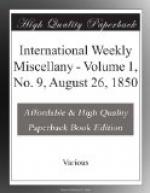The Caliphs dominated over both countries and over both sects. Under their orthodox protection the Sunnite doctrines were able to strike root in Balkh and Samarkand—the ancient Turan, and therefore hostile to Iran and Persia. When Islam was reorganized after the anarchy which ensued upon the overthrow of the Caliphs, Persia became the appanage of the Sophis or Shiite dynasty; the regions to the West of the Euphrates—the ci-devant Roman Empire—acknowledged the rule of the Turkish dynasties, which were Sunnite. On the Oxus and further East—the old Turan—the Sunnite sect was sufficiently strong to defy the efforts of the Shiite sovereigns of Persia to eradicate it. The doctors of Samarkand and Bokhara continued (and continue) as orthodox Sunnites as those of Kufah, Mecca, and Stamboul.
Accordingly, we find the authorities excerpted in the “Futawa Alumgeeree” consist almost exclusively of two classes; they are either the immediate disciples of Hanifa at Kufah and Bagdad, or the jurists of Samarkand and Bokhara. The law-cases they expounded are such as had originated, or might have originated, in those countries—in Babylonia or Turan. And they are for the most part taken from a state of society, and illustrative of social relations, which prevailed in these countries at a period long antecedent to that of Aurunzebe. To attempt to illustrate the civil and social condition of India, under that Emperor by their aid, would be as preposterous as to attempt to illustrate the civil and social condition of those parts of Germany where the Roman law still possesses authority from cases recorded in the Pandects of Justinian.
The real use and value of the “Futawa Alumgeeree” may be briefly explained. In every country in Europe where the Roman law is still recognized as more or less authoritative—and indeed in every country where the common law has borrowed more or less from the Roman—an acquaintance with the system of Roman jurisprudence as it is embodied in the law-books of Justinian has its value for the scientific lawyer. In like manner a knowledge of Mahometan jurisprudence as embodied in the “Futawa Alumgeeree” cannot fail to be instructive for the lawyers of all the countries of Islam, and the lawyers of India, where so much of the existing practical law has been derived from that source. To the general scholar who wishes to master the civil history of Arabia and Babylonia, in which the Sunnite sect, and more particularly the Hanifite subdivision of it, originated, or to familiarize himself with the moral theories which regulate the judgments and actions of the modern Turks, Turcomans, Arabians, and Egyptians, the digest of Aurungzeebee is also a valuable repertory of facts and illustrations.




